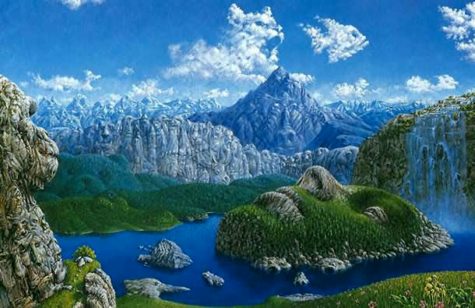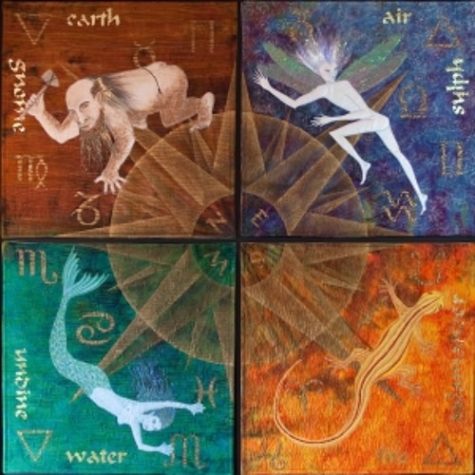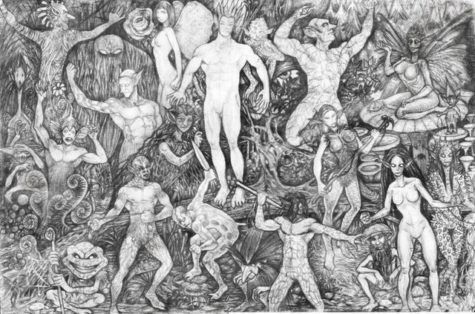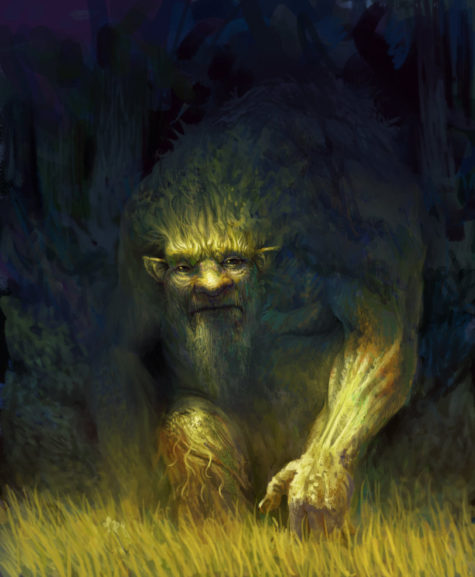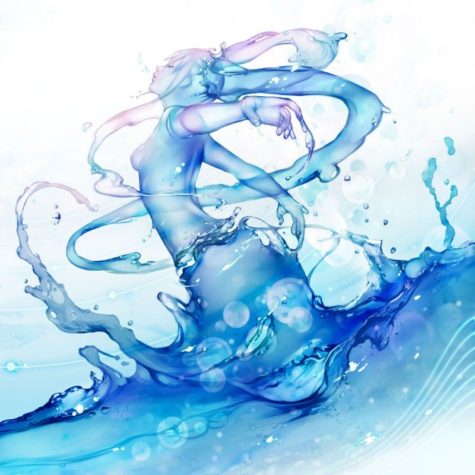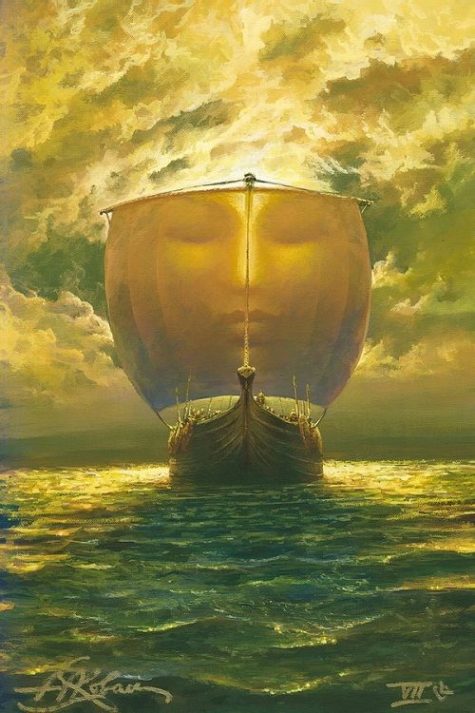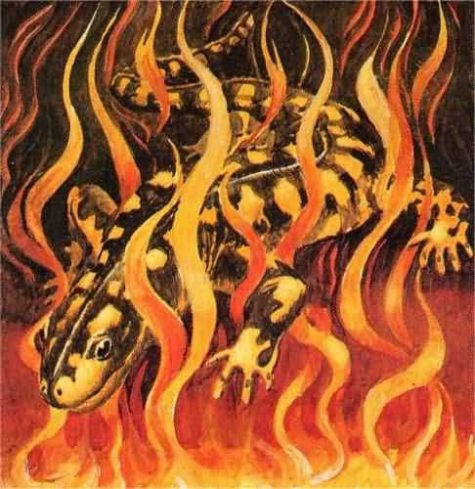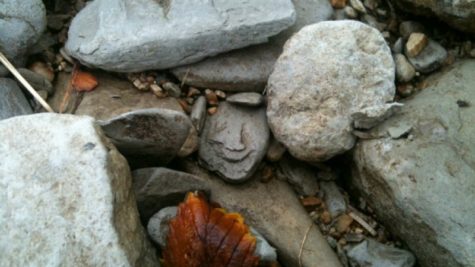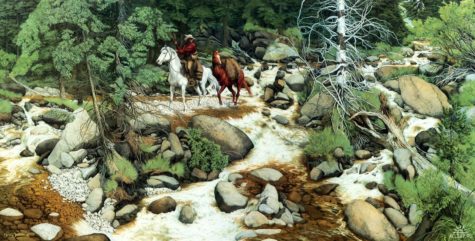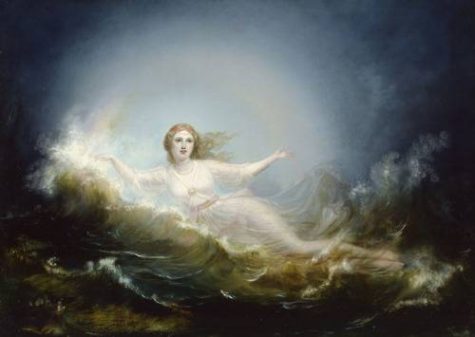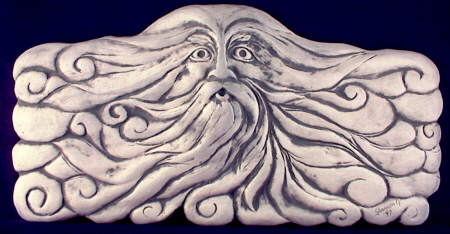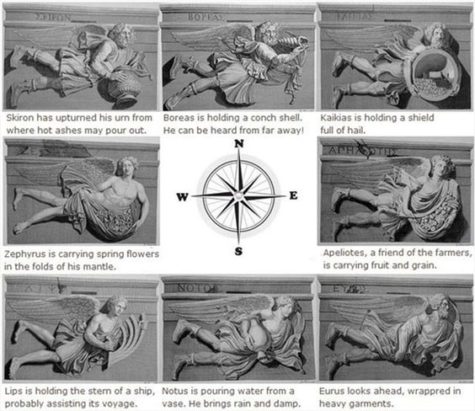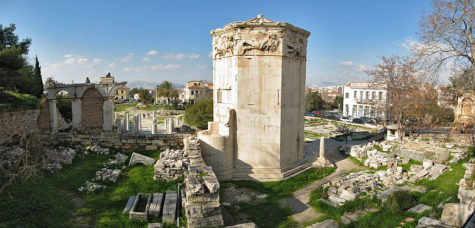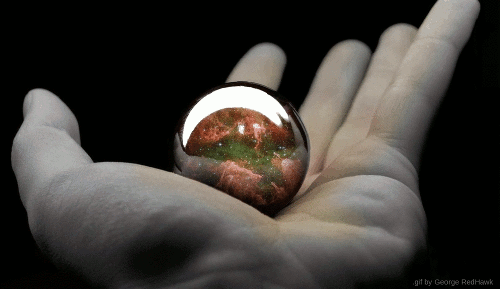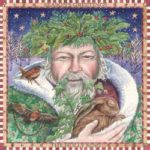Air
Elementals and the Elemental Kingdom contain such creatures (often considered to be mythical) as fairies, goblins, gnomes and elves, leprechauns, tree people, brownies, undines, mermaids and sylphs. They are known as ‘Elementals’ because they are made up of the ‘ethers’ and are ‘ethereal’ and therefore invisible to (most) of us.
Their job is to build and maintain the plant kingdom while working in conjunction with the devas and other earth spirits. They are said to have been here since the beginning of time, have created the landscape of reality, which we return to for different reasons as guided.
Elementals live among plants and animals. They are responsible for the therapeutic effects you feel when outdoors amongst nature, at the beach and sea, at lakes and rivers, in parks and nature reserves, national parks and bushland.
Elemental spirits possess supernatural powers and are usually invisible to humans, living among the trees, rivers, plants, swamps, and mountains. They attach themselves to practically every natural thing. Elementals are the metaphysical; they are the cause of earthquakes, floods, gales, thunderstorms, and wildfires. More importantly, Elementals are responsible for creating, sustaining, and renewing life on Earth.
Elementals particularly do not like the busy and lower vibrations of the inner city life, they tend to stay away. Notice when you are in a busy city, you feel the energy and the vibrations are lower and how everything seems accelerated; it does not feel relaxing or stress free. But when you’re in the country you will notice the energy has a high vibration. It feels comforting, relaxing, quiet, and serene. That is where the Elementals dwell, spend their time, and protecting and loving Mother Earth.
Classical Ideas About Elementals
From the classical Paracelsian perspective there are four elemental categories which correspond to the four elements:
- Gnomes – Earth
- Undines – Water
- Sylphs – Air
- Salamanders – Fire
The classical concept of elementals seems to have been conceived by Paracelsus in the 16th century. He regarded them not so much as spirits but as beings between creatures and spirits, generally being invisible to mankind but having physical and commonly humanoid bodies, as well as eating, sleeping, and wearing clothes like humans.
The Sprites of fiery Termagants in Flame
Mount up, and take a Salamander’s name.
Soft yielding minds to Water glide away,
And sip, with Nymphs, their elemental Tea.
The graver Prude sinks downward to a Gnome,
In search of mischief still on Earth to roam.
The light Coquettes in Sylphs aloft repair,
And sport and flutter in the fields of Air.
— Alexander Pope
Paracelsus gave common names for the elemental types, as well as correct names, which he seems to have considered somewhat more proper, “recht namen”. He also referred to them by purely German terms which are roughly equivalent to “water people,” “mountain people,” and so on, using all the different forms interchangeably.
He noted that undines are similar to humans in size, while sylphs are rougher, coarser, longer, and stronger. Gnomes are short, while salamanders are long, narrow, and lean. The elementals are said to be able to move through their own elements as human beings move through air.
Gnomes, for example, can move through rocks, walls, and soil. Sylphs are the closest to humans in his conception because they move through air like we do, while in fire they burn, in water they drown, and in earth, they get stuck. Paracelsus states that each one stays healthy in its particular “chaos,” as he terms it, but dies in the others.
Paracelsus conceived human beings to be composed of three parts, an elemental body, a sidereal spirit, and an immortal divine soul. Elementals lacked this last part, the immortal soul. However, by marriage with a human being, the elemental and its offspring could gain a soul.
Other Ideas About Elementals
In his influential De Occulta Philosophia, published in 1531-33, Heinrich Cornelius Agrippa also wrote of four classes of spirits corresponding to the four elements. However, he did not give special names for the classes: “In like manner they distribute these into more orders, so as some are fiery, some watery, some aerial, some terrestrial.” Agrippa did however give an extensive list of various mythological beings of this type, although without clarifying which belongs to which elemental class.
The Rosicrucians claimed to be able to see such elemental spirits. To be admitted to their society, it was previously necessary for the eyes to be purged with the Panacea or “Universal Medicine,” a legendary alchemical substance with miraculous curative powers. As well, glass globes would be prepared with one of the four elements and for one month exposed to beams of sunlight. With these steps the initiated would see innumerable beings immediately.
These beings, known as elementals, were said to be longer lived than man but ceased to exist upon death. However, if the elemental were to wed a mortal, they would become immortal. This exception seemed to work in reverse when it came to immortals, though, for if an elemental were to wed an immortal being, the immortal would gain the mortality of the elemental. One of the conditions of joining the Rosicrucians however, was a vow of chastity in hopes of marrying an elemental.
In Jainism, there is a superficially similar concept within its general cosmology, the ekendriya jiva, “one-sensed beings” with bodies (kaya) that are composed of a single element, albeit with a 5-element system (earth, water, air, fire, and plant), but these beings are actual physical objects and phenomena such as rocks, rain, fires and so on which are endowed with souls (jiva).
In the Paracelsian concept, elementals are conceived more as supernatural humanoid beings which are much like human beings except for lacking souls. This is quite the opposite from the Jain conception which rather than positing soulless elementals is positing that physical objects have some type of soul and that what are commonly considered inanimate objects have this particular type of soul.
Gnomes – Tending the Earth
The nature spirits who serve at the physical level are collectively called gnomes. Billions of gnomes tend the earth through the cycles of the four seasons and see to it that all living things are supplied with their daily needs.
- Note: Garden Gnomes serve a slightly different purpose.
They also process the waste and by-products that are an inevitable part of our everyday existence and purge the earth of poisons and pollutants that are dangerous to the physical bodies of man, animal and plant life—including toxic wastes, industrial effluvia, pesticides, acid rain, nuclear radiation and every abuse of the earth.
On spiritual levels, the gnomes have an even heavier chore. They must clean up the imprints of man kind’s discord and negativity that remain at energetic levels in the earth.
War, murder, rape, child abuse, the senseless killing and torture of animals, profit seeking at the expense of the environment as well as hatred, anger, discord, gossip—all these create an accumulation of negatively charged energy that becomes a weight on the earth body and on the nature spirits.
Undines – Guarding the Gardens of the Seas
The elementals whose domain is the water element are collectively known as undines. These beautiful, supple mermaid-like beings are subtle and swift in their movements and can change form rapidly. The undines control the tides and have much to do with the climate as well as oxygenation and precipitation.
The undines also cleanse waters that have been poisoned by sewage, industrial waste, chemicals, pesticides and other substances. They work ceaselessly to heal the polluted seas as they recharge the electromagnetic field of the waters with currents of the Spirit. Their bodies are conductors of cosmic currents resounding through the chambers of submarine life.
The undines cleanse not only the physical waters, but also that aspect of mankind’s life that relates to the water element—our emotional and subconscious world.
They carry on their backs the weight of mankind’s emotional pollution—feelings that are not at peace, such as anger, emotional abuse, unloving speech, selfishness, anxiety and indulgence.
Sylphs – Aerating Life with the Sacred Breath
The sylphs tend the air element, directing the flow of air currents and atmospheric conditions. They purify the atmosphere and aerate every cell of life with the sacred breath of Spirit. They are bearers of the life-sustaining prana that nourishes all living things. On subtle levels, the sylphs transmit the currents of the Spirit from heaven to earth.
The sylphs often have thin, ethereal bodies that transform gracefully into myriad shapes as they soar through the air. Sylphs are able to travel at great distances very quickly, and giant sylphs can actually span the skies and interpenetrate the earth, the water and the fire elements.
Like giant transformers, sylphs conduct the currents of the mind of God unto the mind of man. They also work to purify the air of pollutants—everything from car exhaust to toxic fumes emitted from factories and other industrial processes—before these can pollute the water and the earth.
The air element corresponds to the mental level of existence, and thus the sylphs also have the job of purifying the mental plane. The mental plane can become polluted by negative thoughts that feed hatred, anger, racial prejudice, religious bigotry, resentment, pride, ambition, greed, jealousy and other poisons of the spirit.
Salamanders – Infusing Matter with the Fires of Creation
The fourth group of elementals work with the fire element and are collectively known as salamanders. Their job is crucial, for they serve at the atomic level of all organic and inorganic life, infusing the molecules of matter with the spiritual fires of creation.
The salamanders imbue the entire creation with the energies of the Spirit necessary to sustain life on earth. Capable of wielding both the most intense fires of the physical atom and the purifying, spiritual fires of Spirit, they control the spiritual-material oscillation of light within the nucleus of every atom.
Whether in electricity, firelight or the flame of a candle, the salamanders are agents for the transfer of the fires of the subtle world for mankind’s daily use. Without the spark of life sustained by the salamanders, life and matter begin to decay, corrode and disintegrate.
The burdens upon the salamanders range from the weight of mankind’s hatred to irresponsible uses of nuclear energy. Were it not for the fiery salamanders absorbing and transmuting the huge conglomerates
of negativity over the large cities of the world, crime and darkness would be much more advanced than it is today.
The very sustaining of life—the air we breathe, the food we eat, the water we drink—is something most of us take for granted. Yet at the most basic level, we are utterly dependent on the selfless service of the nature spirits. The miracle of life is the miracle of the gnomes, sylphs, undines and salamanders.
How To See Elementals
From Melanie the Medium, we have this nice little article about how to see Elemental Spirits:
Mark and I were having fun skipping rocks in the creek by our house when I saw a Nature Spirit in the rocks smiling at us. I was so startled when I saw him, and then of course I was so happy! I love to see Nature Spirits! I’ve seen more of them since I’ve been increasing my connection to nature over the past few years. Today I’m going to share with you a few things I’ve learned about Nature Spirits that can help you see them as well!
There are Nature Spirits in trees, rocks, water, around flowers…wonderful loving spirits all around you. To connect with them, start spending more time in nature. Go for walks and talk to the trees, rocks, water, wind…whatever appeals to you. You can even sit in your garden and do this. It also helps when you show the natural spaces around you love and appreciation.
Become aware of the energy of nature and open your mind to the possibility that you can communicate with these wonderful Spirits.
The first time I saw Nature Spirits was when I saw Tree Spirits in Ireland. The faces weren’t physical indentations on the bark of the trees. They appeared as whitish outlines of faces superimposed on the tree trunks. Mark and I both saw them, and it was very exciting!
Then, I asked my Spirit Guides to help me see gnomes and fairies. I saw my first gnome in Scotland. Mark and I were on a walk, and suddenly I was startled by the image of a face on the ground in front of me. It was about the size of a quarter, and I saw it superimposed over a leaf on the ground. It used the physical object of the leaf to help me see what it looked like. It was a brown, wrinkled leaf. In my mind I saw the full image of the gnome, and his face was deeply wrinkled like the leaf.
I’ve seen several more gnomes and a fairy since then, and each time they have appeared using some of the natural objects around me to help me see what they look like. That’s what my rock friend did! He helped me become aware of his presence using a rock that looks like a face.
Sometimes Nature Spirits appear in ways that anyone can look at and notice a clear face (like my rock friend), and other times they are more hidden and you can see them in your mind, as if you are seeing their image superimposed over a natural object.
Just like people, some Nature Spirits don’t want their picture taken. If I see one that I think will show up in a photo, I always ask if it is okay to take a picture. Sometimes those special moments with them are meant just for you.
When you see a Nature Spirit, it will stand out to you. You will feel its presence when you see it. You don’t have to try to see faces in every little pebble and leaf. A Nature Spirit will make itself known to you and you will feel its presence.
Feeling a Nature Spirit’s presence is just as valid and wonderful as seeing it, so don’t be discouraged if you don’t see one at first. Focus on feeling the energy of the plants, nature, and Nature Spirits around you when you are spending time in nature.
Tell your Spirit Guides you would like to become aware of the Nature Spirits, and then spend more time appreciating the natural environment around you. Care for it and nurture it. If you see trash on the ground, pick it up as an act of love. If you have an area of your garden that could use some extra attention, spend time tending it while feeling your love and appreciation for the nature around you. Be patient, and with time, you will start to become aware of Nature Spirits as well!
I hope this inspires you to spend more time in nature and feel your connection to the energy around you and the wonderful Nature Spirits!
Sending you love, Melanie Jade 🙂
Prayer to Heal Millions of Elementals
In the name of my mighty I AM Presence and my Higher Self and by the love, wisdom and power of the flame within my heart, I call forth the action of transmutation by the fire of my being, multiplied by the violet flame. I call forth this action on behalf of all elemental life.
I call for that portion of the flame I invoke and all that I AM to go forth now to heal millions upon millions of elementals in the earth!
I dedicate my lifestream to the liberation of all elemental life. And I accept it done this hour in full power according to the will of God. Amen.
Sources:
- Titles: Daughter of Nature, Goddess of Creation, Water Mother, Sky Mother
- Other Names: Luonnotar, Luonotar
- Origin: Finland
- Depicted as: Virgin floating on the sea
- Feast day: August 26
The name Ilmatar is derived from the Finnish word ilma, meaning “air,” and the suffix -tar, denoting a female spirit. Thus, her name literally means “female air spirit.” In the Kalevala she was also occasionally called Luonnotar,which means “female spirit of nature” (Finnish luonto, “nature”)
The story is as follows:
In the beginning, says the Kalevala, there was only Ilmatar, the void and a great deal of wind. She was alone in the beginning of time. She lived in the heavens, but eventually she grew restless and slipped into the vast cosmic sea. She floated and frolicked for centuries on this primordial ocean, counting rainbows and letting the wind play in her hair.
She began to long for a son.Her longing was so great that the East Wind itself took pity. She found herself buffeted and tossed by the wind’s tempestuous love-making until, exhausted, she could bear it no longer and collapsed. During this storm she became pregnant. And there, inside her, was conceived Vainamoinen, the child of the wind.
The goddess floated for centuries on this primordial ocean, unable to give birth because there was no land. She prayed constantly to the god Ukko, the highest of the gods, to help her. After seven centuries or so she began to give up hope, and Ukko took pity on her and sent a duck.
The poor bird was desperately looking for somewhere to land so she could make a nest and lay her eggs. When Ilmatar saw the bird’s predicament, she helpfully raised her knee and the bird came swooping down. Half a dozen cosmic eggs were laid, followed by an egg made of iron. The bird then gathered them all up, sat upon them and went to sleep.
Luonnotar sat and watched the bird eagerly, happy for something to finally be happening after centuries of loneliness and boredom. She became too excited, however, her leg began to heat up, she became extremely uncomfortable. Slowly, carefully, she began to stretch out her leg.. and slowly, inevitably, the seven eggs rolled off and fell majestically into the raging sea.
Now, cosmic eggs are delicate things, as soon as they fell into the waters, they broke open. Ilmatar watched in amazement as the broken shells of the eggs formed the heavens and the earth. The yolks became the sun, the whites the moon, and scattered fragments of the eggs transformed into the stars.
And thus the world was formed. As for the iron egg, the black yolk became a thundercloud.
Ilmatar was delighted with events, and busied herself shaping the lands and adding finishing touches. Even though dry land was now available, Ilmatar continued to carry the child within her for thirty summers while she finished her work. Eventually, she felt a stirring inside her. Vainamoinen had woken up after 30 years of being in the womb and was eager to see the new world. He had quite a struggle to get out, but he managed in the end and eventually, Ilmatar gave birth to Vainamoinen, a bouncing bonny old man, and the worlds first shaman, who then finished her creation.
Compiled from various sources
- Origin: Greece
- Festival Days: Jan 16 and 17 – Greek festival in which offerings were made to the Wind Gods of the Eight Directions
In ancient Greek religion and myth, the Anemoi (Greek: Ἄνεμοι, “Winds”) were wind gods who were each ascribed a cardinal direction from which their respective winds came, and were each associated with various seasons and weather conditions.
They were sometimes represented as mere gusts of wind, at other times were personified as winged men, and at still other times were depicted as horses kept in the stables of the storm god Aeolus, who provided Odysseus with the Anemoi in the Odyssey. The Spartans were reported to sacrifice a horse to the winds on Mount Taygetus. Astraeus, the astrological deity, and Eos/Aurora, the goddess of the dawn, were the parents of the Anemoi, according to the Greek poet Hesiod. The daughters of the Anemoi are the Aurae (wind nymphs).
According to Hesiod, the beneficial winds, Notus, Boreas, Argestes, and Zephyrus, were the sons of Astraeus and Eos, and the destructive ones, as Typhon, are said to be the sons of Typhoeus. Later, especially philosophical writers, endeavoured to define the winds more accurately, according to their places in the compass.
The Anemoi are divided into two groups:
- Anemoi Major
- Boreas: North Wind
- Eurus: East Wind
- Notus: South Wind
- Zephyr: West Wind
- Anemoi Minor
- Apeliotes: Southeast Wind
- Kaikias: Northeast Wind
- Livos (Lips): Southwest Wind
- Skiron (Skeiron): Northwest Wind
Of the four chief Anemoi, Boreas (Aquilo in Latin) was the north wind and bringer of cold winter air, Zephyrus (Favonius in Latin) was the west wind and bringer of light spring and early summer breezes, and Notos (Auster in Latin) was the south wind and bringer of the storms of late summer and autumn; Eurus, the southeast (or according to some, the east) wind, was not associated with any of the three Greek seasons, and is the only one of these four Anemoi not mentioned in Hesiod’s Theogony or in the Orphic Hymns.
Other Minor Wind Deities:
- Argestes “clearing”, a wind blowing from about the same direction as Skiron (Caurus), and probably another name for it
- Aparctias, sometimes called the north wind instead of Boreas
- Thrascias, the north-north-west wind (sometimes called in Latin Circius)
- Euronotus, the wind blowing from the direction, as its name suggests, between Euros and Notos, that is, a south-southeast wind (Euroauster to the Romans)
- Iapyx, the northwest wind about the same as Caurus. It was this wind, according to Virgil, that carried the fleeing Cleopatra home to Egypt after she was defeated at the battle of Actium.
- Libonotus, the south-southwest wind, known as Austro-Africus to the Romans
- Meses, another name for the north-west wind Skiron
- Olympias, apparently identified with Skiron/Argestes
- Phoenicias, another name for the southeast wind (“the one blowing from Phoenicia”, due to this land lying to the south-east of Greece)
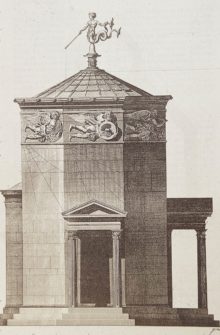 The most remarkable monument representing the winds is the octagonal tower of Andronicus Cyrrhestes at Athens. Each of the eight sides of the monument represents one of the eight principal winds in a flying attitude.
The most remarkable monument representing the winds is the octagonal tower of Andronicus Cyrrhestes at Athens. Each of the eight sides of the monument represents one of the eight principal winds in a flying attitude.
A moveable Triton in the centre of the cupola pointed with his staff to the wind blowing at the time.
All these eight figures have wings at their shoulders, all are clothed, and the peculiarities of the winds are indicated by their bodies and various attributes.
This is how it looks today:
